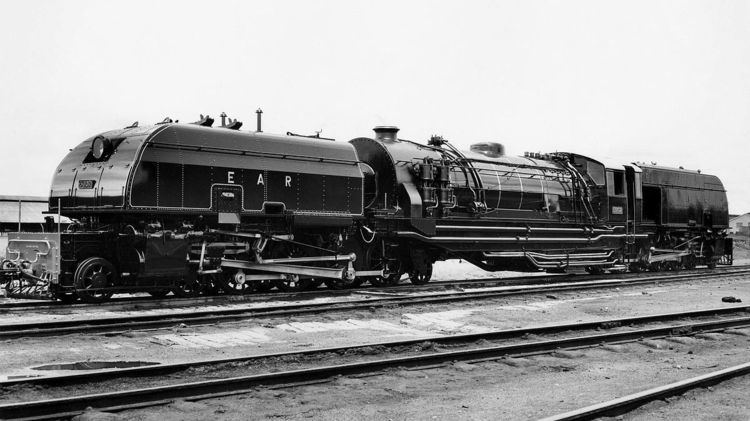Power type Steam Order number 11164, 11168 Build date 1955 | Builder Beyer, Peacock & Co. Serial number 7632–7658, 7700–7706 Total produced 34 | |
 | ||
The EAR 59 class was a class of oil-fired 1,000 mm (3 ft 3 3⁄8 in) gauge Garratt-type articulated steam locomotives. The 34 members of the class were built by Beyer, Peacock & Co. in Manchester, England, for the East African Railways (EAR). They entered service in 1955–56, and were the largest, heaviest and most powerful steam locomotives to operate on any metre gauge railway in the world.
Contents
Description
The locomotives had a 4-8-2+2-8-4 wheel arrangement, weighed 252 tons, and delivered a tractive effort of 83,350 lbf (370.76 kN). They were designed to haul 1,200-ton trains on 1.5% gradients and were the mainstay of freight services on the 330-mile run from Mombasa to Nairobi until the late 1970s.
During normal service the locomotives were manned by two regular crews on a 'caboose' basis, one working and one resting in a van with sleeping accommodation, changing over at eight-hour intervals.
The engines, many with Sikh drivers, were kept very clean and the cabs were polished and immaculate. The most famous was 5918 Mount Gelai with a devoted crew known as the 'Magnificent Foursome' who worked her for 16 years. The two drivers, Kirpal Singh and Walter Pinto, when the locomotive went into the works at Nairobi for scheduled maintenance they simply took their holidays.
According to railway photographer Colin Garratt (in 1975), 'the overall condition of Mount Gelai is possibly unrivalled anywhere in the world today. Her cab interior is more akin to a Sikh Temple than a locomotive footplate for its boiler face abounds in polished brasswork, embellished with mirrors, clocks, silver buckets and a linoleum floor'.
Withdrawal started in 1973 with the last locomotive (Mount Gelai) removed from service in April 1980 when it was driven by its long time driver, Kirpal Singh directly to the railway museum. Mr Singh retired from railway service the same day. Together with Mount Gelai, Mount Shengena was also saved from the scrapyard and both are now preserved by the Nairobi Railway Museum.
In August 2001 Mount Gelai was removed from the Railway Museum and towed to Kenya Railways main works for overhaul to operating condition. Between November 2001 and September 2005 the locomotive made three round trips to Mombasa hauling excursion trains. It was also used on a least one occasion to haul a freight train to Nairobi due to a diesel locomotive shortage. However, it has not operated outside the confines of Nairobi since 2005 and is unlikely to do so again due to operational restrictions and the at least partial replacement of Kenya's meter gauge (1,000 mm (3 ft 3 3⁄8 in)) rail lines with standard gauge (1,435 mm (4 ft 8 1⁄2 in)) lines.
Names
The locomotives were named after mountains in East Africa:
